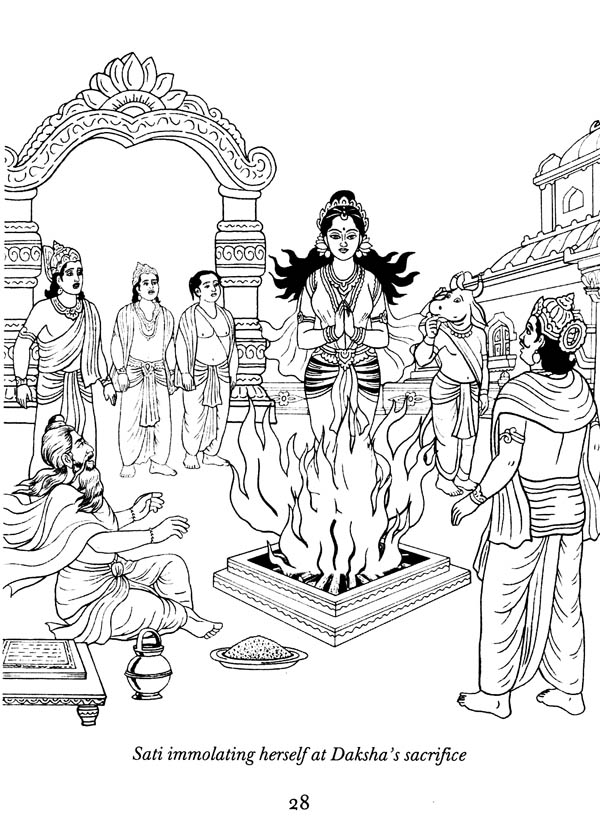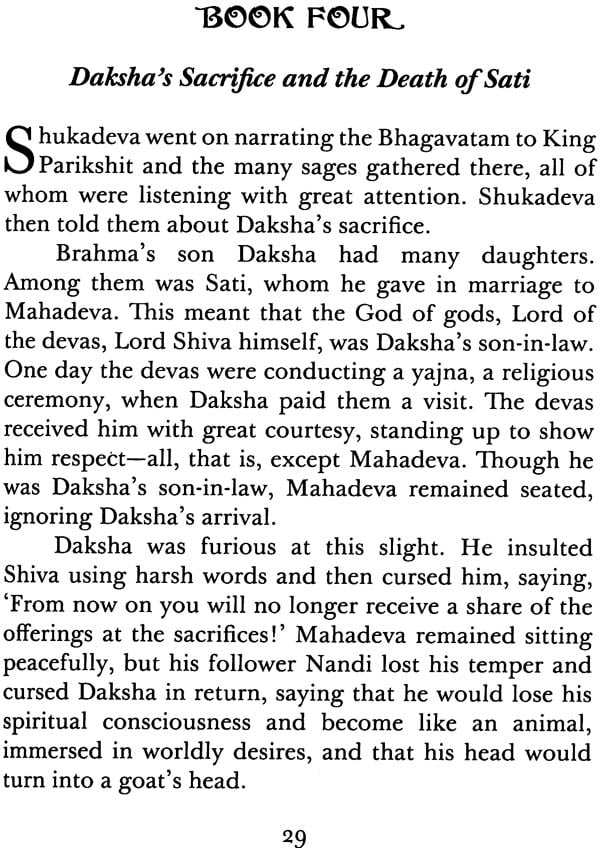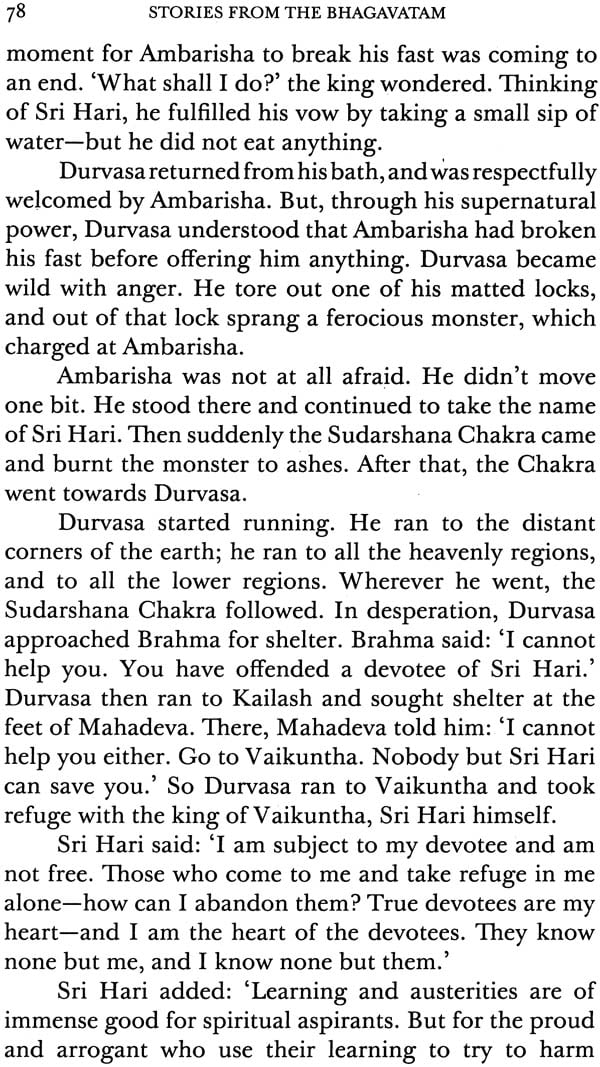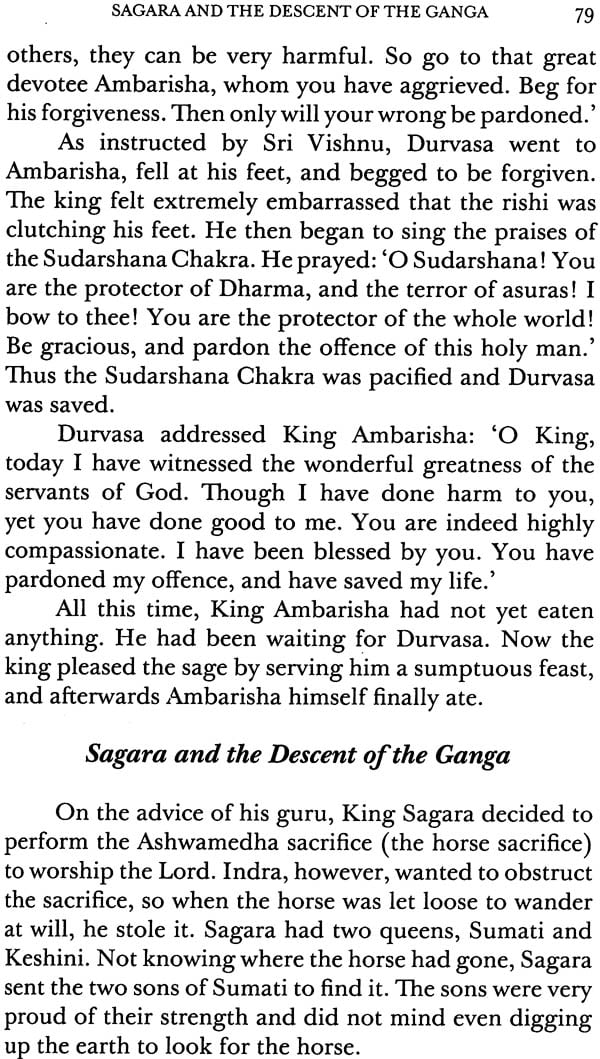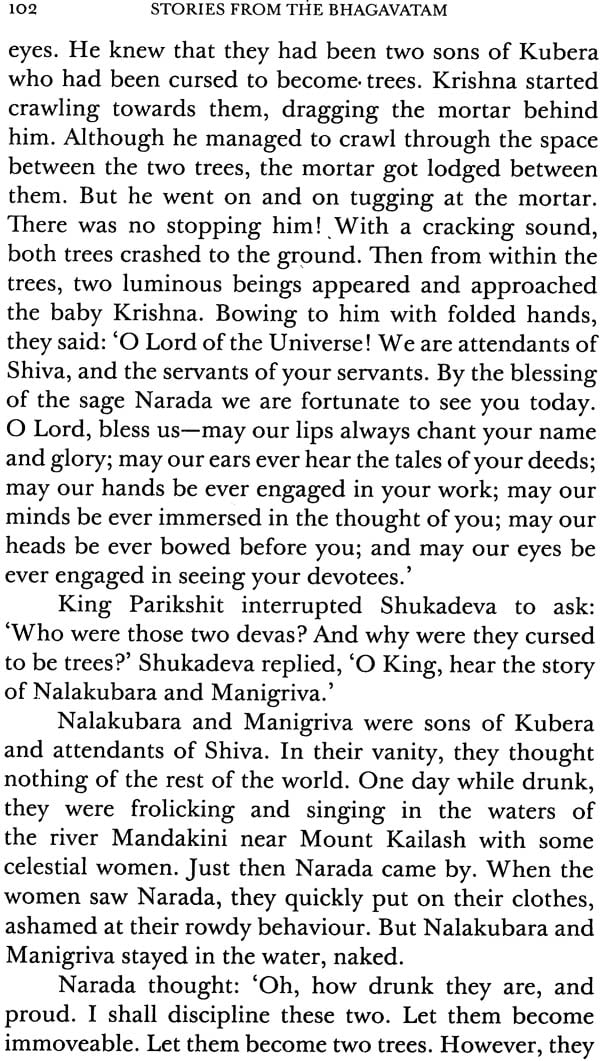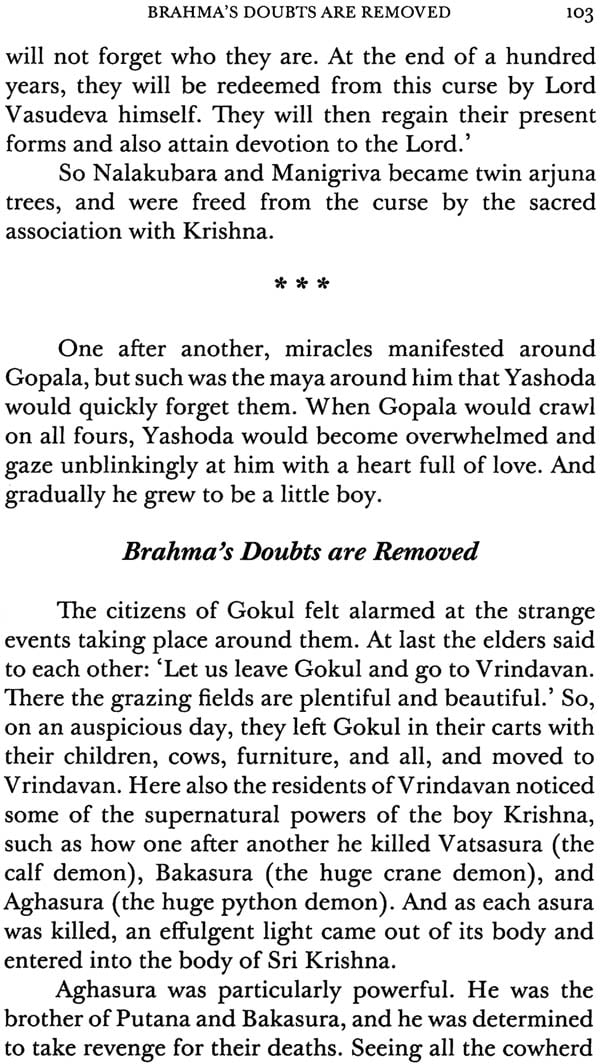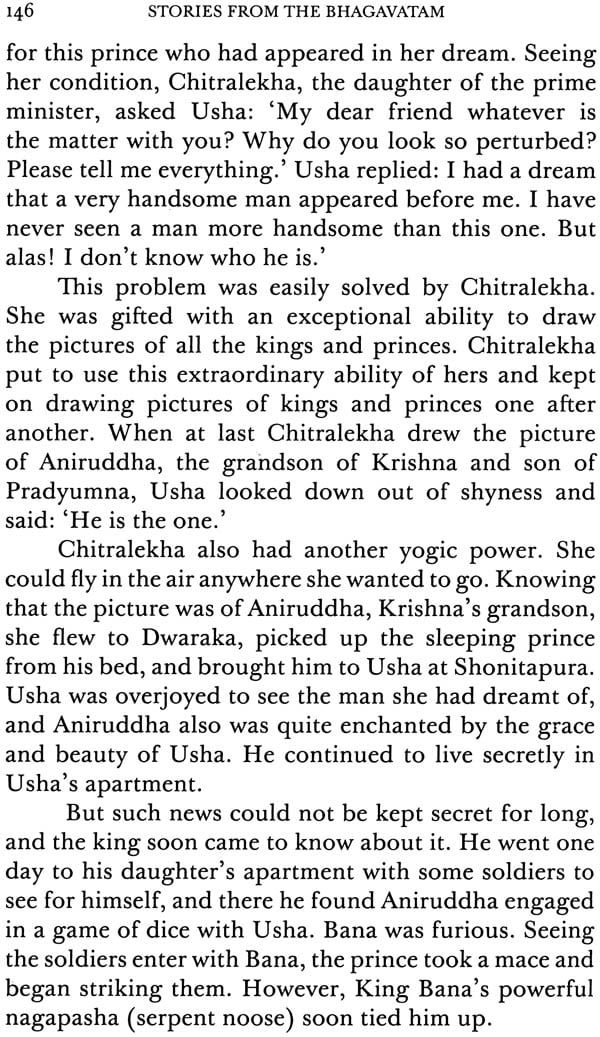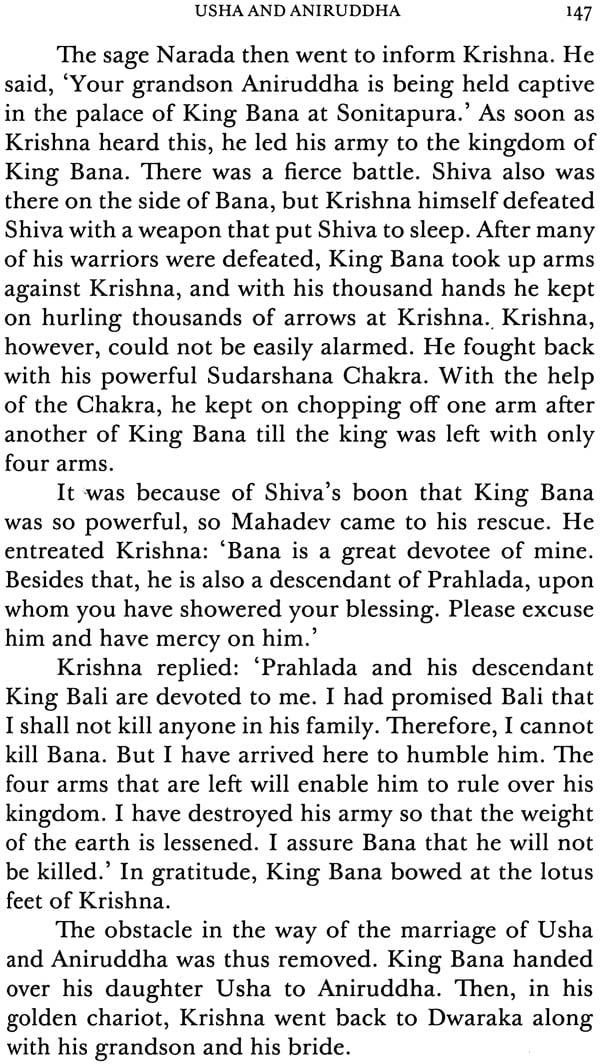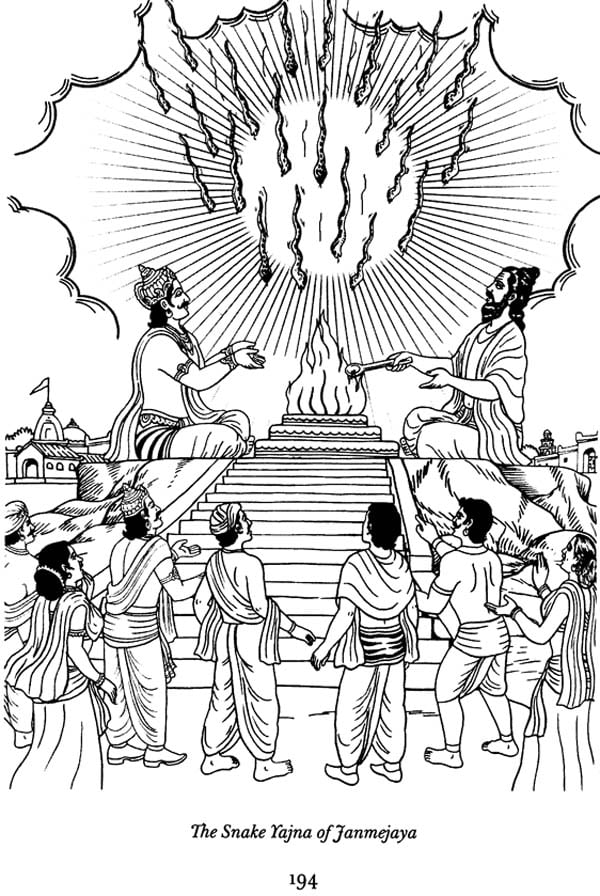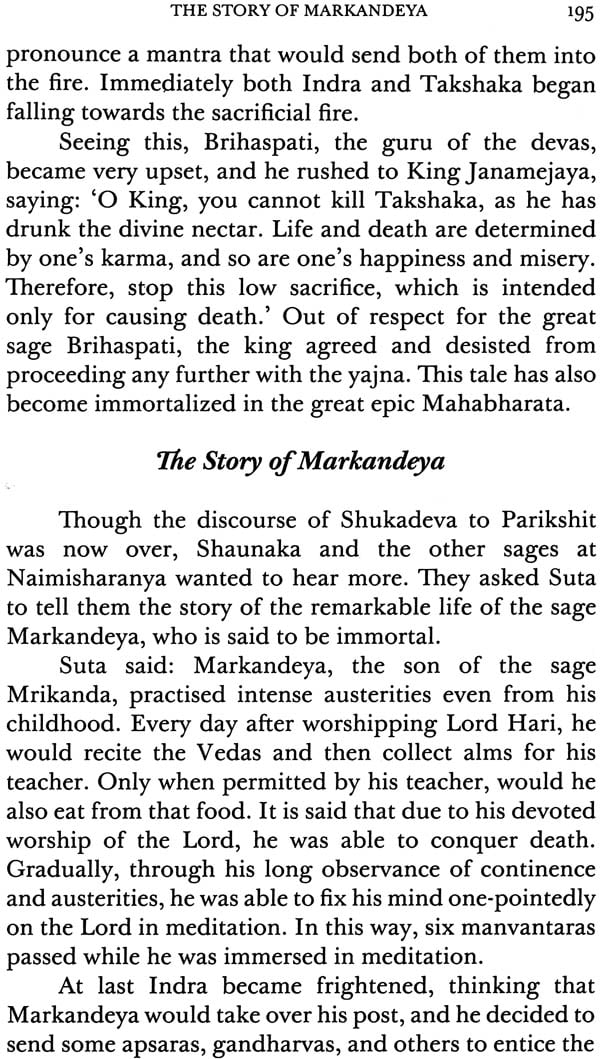
Stories from The Bhagavatam
Book Specification
| Item Code: | NAK159 |
| Author: | Swami Bodhasarananda |
| Publisher: | ADVAITA ASHRAM KOLKATA |
| Language: | English |
| Edition: | 2018 |
| ISBN: | 9788175054349 |
| Pages: | 198 (12 B/W Illustrations) |
| Cover: | Paperback |
| Other Details | 8.5 inch x 5.5 inch |
| Weight | 220 gm |
Book Description
Few scriptures have had such great influence on a religion and culture as the Srimad Bhagavatam has. Along with the Bhagavad Gita and the main text of versions of the Ramayana, it has been the main text of most of the Vaishnava schools of India after Ramanuja. Probably composed in its final form around the tenth century, it was greatly influenced by the Advaitic theology school of Vedanta-though Visishtadvaita and Dvaita are also given their due. But in spite of the Advaitic theology in it, the Bhagavatam was also heavily influenced by the songs of ecstatic divine love written by the Alvars, the Vaishnava saints of Tamil Nadu who lived between the six and ninth centuries.
The Alvar songs set a new standard for devotional fervour and poetry. Loving devotion became ecstatic devotion. Devotional poetry became sublime lyricism. This influence on the Bhagavatam can clearly be seen if we compare sections of the older Vishnu Purana with those in the later Bhagavatam.
Though most of the stories in the Bhagavata Purana are basically the same as those in the Vishnu Purana, the relationship between the Lord and his devotees takes a new turn in the Bhagavatam, and this also brings about a change in the teaching and Philosophy for instance, in the stories of both Prahlada and gopis in the Bhagavatam, their minds become so absorbed in the thought of the lord that feel they are the Lord, and they start imitating some of his actions.
Why are these stories so important? Myths and religious stories are actually pointers to another realm, a divine realm. They raise our awareness away from this mundane physical plane and take us to a higher plane of consciousness. Sometimes they do this through obvious teachings, sometimes through allegories, but very often they do it by working on a deeper level of our consciousness and we ate hardly aware of the impact they make on us.
The story of the Avadhuta, given in the 11th skandha of the Bhagavatam, would be an example of a story with obvious teachings. So also is the story of King Bharata, in the 5th skandha. There the teachings are spelled out. Regarding allegories, the Bhagavatam itself unabashedly admits that the story of Puranjana in the 4th skandha is an allegory. Probably the story of Gajendra, in the 8th skandha, is also one.
One of the most wonderful examples of the third kind of story, or myth-that is, one that works on a deeper level of our consciousness is the story of Markandeya, given in the 12th skandha. This is a type of myth that has no particular meaning that we can attribute to it. It speaks of a mysterious spiritual experience, and works on the subtle level of our mind to awaken our spiritual consciousness.
But then there are stories like that of Prahlada, which are possinly a combination of some of all of the above. They are partly teachings, partly allegorical, and partly pure myth. Readers should feel free to check out all the stories presented here and make their own judgements. But as we said readers should also remember not all stories have meanings'.
The stories of Krishna, which comprise the largest section of the Bhagavatam, most likely also have a combination of all these elements. Though there may be teachings, and there may even be allegories, yet general rasa (flavour) of each story is meant to be savoured within. The Stories are meant to feed our inner soul. Otherwise, much of the benefit is lost.
We should also remember that there are many Puranas that give these same stories. But just as there are many Ramayanas that tell different versions of the story of Rama and Sita, so also each Purana tells its own version of each story. In fact, the Bhagavatam itself has its own version of the Ramayana – one with a surprising twist to it.
Why don't the Puranas all tell same Version of each story? What the Puransas are trying to say is that it doesn't matter if there are different versions of the same story. And in fact, it doesn't even matter if these stories are historical or not. The point is not whether Krishna lived at a certain time and enacted a certain lila in a certain way, and at a certain place. For the devotees, the real point is that Krishna lives now – here and now. For them, he still esists and he is still enacting his lilas. The same goes for Rama and other characters from these stories. The point the puranas are making is that if we listen to these stories with our minds as well as our ears-really listen to them – the divine dramas of Krishna (or Rama) will be awakened in our heart.
These Puranas then and particularly the Bhagava purana-are manuals for spiritual life. The stories are there to inspire us to search within. The more we get a taste for them, the more will work on our minds. This is why the present volume focuses on the stories.
However, we still much fact critics who dismiss myths and stories as being unhistorical and unscientific. Such critics cannot understand what relevance these stories can possibly have for people of our time. To answer this swami Vivekanaanda said to an audience in the USA, "it is good for you to remember, in this country especially that the world's great spiritual giants have all been produce only by those religious sects which have been in possession of very rich mythology and ritual."
Bemoaning the lack of development of myth in Western civilizations, Carl Jung once wrote: our myth has become mute, and gives no answers. The fault lies not in it as it is set down in the scriptures, but solely in us, who have not developed it further, who rather, have suppressed any such attempts. The original version of the myth offers ample points of departure and possibilities of development. We are very fortunate that this is not the case in India. Perhaps no other country in the world has delighted so much in the development and redevelopment of its mythology as India. And this is one of the reasons why, when Westerners visit India, they often mention how they are inspired by the spiritual atmosphere there.
Western countries need to take note of this. Is a totally rational' or totally scientific outlook enough to feed the spirit within? Besides feeding our religious instincts, mythology also feeds our poetry and all the other arts. And what would life be like without them?
| Publisher's Note | 7 | |
| Introduction | 9 | |
| Book one | A Minstrel Shares the Bhagavata | 13 |
| The Incarnation Story | 14 | |
| King Parikshit | 15 | |
| Book Two | Shukadeva's Advice | 19 |
| The Story of Khatvanga | 19 | |
| Book Three | Vidura Meets Uddhava and Maitreya | 21 |
| Jaya and Vijaya | 23 | |
| Kapila Muni | 25 | |
| Book Four | Daksha's Sacrifice and the Death of Sati | 29 |
| The Story of Dhruva | 33 | |
| The Story of Puranjana | 36 | |
| Book Five | Jada Bharata | 40 |
| Book Six | Ajamila | 47 |
| Dadhichi's Gift, and the Killing of Vritrasura | 50 | |
| Book Seven | Prahlada | 55 |
| Book Eight | The Liberation of the Elephant King | 64 |
| The Churning of the Ocean | 66 | |
| Bali and Vamana | 69 | |
| Incarnation as a Fish | 73 | |
| Book Nine | Ambarisha and Durvasa | 76 |
| Sagara and the Descent of the Sanga | 79 | |
| The Incarnation of Rama | 82 | |
| The Story of Parashurama | 84 | |
| Yayati and Devayani | 86 | |
| Dushyanta and Shakuntala | 89 | |
| Rantideva | 90 | |
| Book Ten | The Birth of Sri Krishna | 93 |
| The Salvation of Putana | 98 | |
| Shakatasura and Trinavarta | 98 | |
| Yashoda sees the Universe in Krishna | 99 | |
| Sri Krishna is Bound | 100 | |
| Nalakubara and Manigriva are Liberated | 101 | |
| Brahma's Doubts are removed | 103 | |
| The Serpent Kaliya is Tamed | 106 | |
| Balarama Kills the Bemon Pralambha | 108 | |
| Krishna steals the Gopis' Clothes | 109 | |
| Krishna Blesses the Pious Brahmin women | 110 | |
| Lifting mount Govardhana | 111 | |
| Rasa Lila | 114 | |
| Sudarshana, Shankhachuda and Arishtamura | 119 | |
| Akrura Comes for Krishna and Balarama | 121 | |
| The Killing of Kamsa | 125 | |
| Ugrasena is Enthroned | 130 | |
| Guru-dakshina of Krishna and Balarama | 131 | |
| Uddhava and the Gopis' Complaint | 133 | |
| News from hastinapura | 135 | |
| Fight with Jarasandha | 136 | |
| Kalayanvana and Muchkunda | 137 | |
| Kalayvana and Muchukunda | 139 | |
| Rukimini Marries Karan | 141 | |
| Pradyumna the symantaka Jewel: Jambavati and Satyabhama | 142 | |
| A Conversation with kunti in indrprastha | 144 | |
| Usha and Aniruddha | 145 | |
| Narada's Visit to dwaraka | 148 | |
| The killing of Jarasand | 149 | |
| Hte rajasyajna and the killing of Shishupala | 152 | |
| Destruction of Shalva and Dantakaktra | 154 | |
| The story of Sridama | 155 | |
| Vrikasura attacks Mahadeva | 158 | |
| Bhrigu of footprint | 161 | |
| Dwaraka and the Yadu Dynasty | 162 | |
| Book Eleven | The Curse of the Sages | 164 |
| The Nava Yogis | 165 | |
| Sri Krishna and Uddhava | 173 | |
| Uddhava Gita | 175 | |
| The Twenty four gurus of the Avadhuta | 176 | |
| Bondage and freedom | 182 | |
| The Glory of God | 183 | |
| Questions and Answer | 185 | |
| Thelast advice of Sri Krishna to Uddhava | 186 | |
| Krishna returns to his Heavely realm | 187 | |
| Book Twelve | Yuga Dharma and the last advice of Shukadeva | 191 |
| Parikshit's Illumintion | 192 | |
| The Snake Yajna or janamejaya | 193 | |
| The Story of Markandeya | 195 | |
| The Essence of the Bhagavatam in four Shlokas | 198 | |
